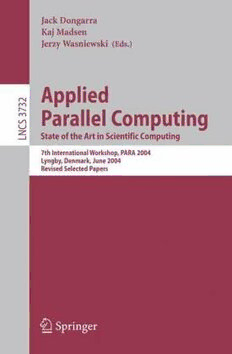Download Applied Parallel Computing. State of the Art in Scientific Computing: 7th International Workshop, PARA 2004, Lyngby, Denmark, June 20-23, 2004. Revised Selected Papers PDF Free - Full Version
Download Applied Parallel Computing. State of the Art in Scientific Computing: 7th International Workshop, PARA 2004, Lyngby, Denmark, June 20-23, 2004. Revised Selected Papers by Richard P. Brent (auth.), Jack Dongarra, Kaj Madsen, Jerzy Waśniewski (eds.) in PDF format completely FREE. No registration required, no payment needed. Get instant access to this valuable resource on PDFdrive.to!
About Applied Parallel Computing. State of the Art in Scientific Computing: 7th International Workshop, PARA 2004, Lyngby, Denmark, June 20-23, 2004. Revised Selected Papers
Introduction The PARA workshops in the past were devoted to parallel computing methods in science and technology. There have been seven PARA meetings to date: PARA’94, PARA’95 and PARA’96 in Lyngby, Denmark, PARA’98 in Umea, ? Sweden, PARA 2000 in Bergen, N- way, PARA 2002 in Espoo, Finland, and PARA 2004 again in Lyngby, Denmark. The ?rst six meetings featured lectures in modern numerical algorithms, computer science, en- neering, and industrial applications, all in the context of scienti?c parallel computing. This meeting in the series, the PARA 2004 Workshop with the title “State of the Art in Scienti?c Computing”, was held in Lyngby, Denmark, June 20–23, 2004. The PARA 2004 Workshop was organized by Jack Dongarra from the University of Tennessee and Oak Ridge National Laboratory, and Kaj Madsen and Jerzy Was ´niewski from the Technical University of Denmark. The emphasis here was shifted to high-performance computing (HPC). The ongoing development of ever more advanced computers provides the potential for solving increasingly dif?cult computational problems. However, given the complexity of modern computer architectures, the task of realizing this potential needs careful attention. For example, the failure to exploit a computer’s memory hi- archy can degrade performance badly. A main concern of HPC is the development of software that optimizes the performance of a given computer. The high cost of state-of-the-art computers can be prohibitive for many workplaces, especially if there is only an occasional need for HPC.
Detailed Information
| Author: | Richard P. Brent (auth.), Jack Dongarra, Kaj Madsen, Jerzy Waśniewski (eds.) |
|---|---|
| Publication Year: | 2006 |
| ISBN: | 9783540290674 |
| Pages: | 1194 |
| Language: | English |
| File Size: | 15.415 |
| Format: | |
| Price: | FREE |
Safe & Secure Download - No registration required
Why Choose PDFdrive for Your Free Applied Parallel Computing. State of the Art in Scientific Computing: 7th International Workshop, PARA 2004, Lyngby, Denmark, June 20-23, 2004. Revised Selected Papers Download?
- 100% Free: No hidden fees or subscriptions required for one book every day.
- No Registration: Immediate access is available without creating accounts for one book every day.
- Safe and Secure: Clean downloads without malware or viruses
- Multiple Formats: PDF, MOBI, Mpub,... optimized for all devices
- Educational Resource: Supporting knowledge sharing and learning
Frequently Asked Questions
Is it really free to download Applied Parallel Computing. State of the Art in Scientific Computing: 7th International Workshop, PARA 2004, Lyngby, Denmark, June 20-23, 2004. Revised Selected Papers PDF?
Yes, on https://PDFdrive.to you can download Applied Parallel Computing. State of the Art in Scientific Computing: 7th International Workshop, PARA 2004, Lyngby, Denmark, June 20-23, 2004. Revised Selected Papers by Richard P. Brent (auth.), Jack Dongarra, Kaj Madsen, Jerzy Waśniewski (eds.) completely free. We don't require any payment, subscription, or registration to access this PDF file. For 3 books every day.
How can I read Applied Parallel Computing. State of the Art in Scientific Computing: 7th International Workshop, PARA 2004, Lyngby, Denmark, June 20-23, 2004. Revised Selected Papers on my mobile device?
After downloading Applied Parallel Computing. State of the Art in Scientific Computing: 7th International Workshop, PARA 2004, Lyngby, Denmark, June 20-23, 2004. Revised Selected Papers PDF, you can open it with any PDF reader app on your phone or tablet. We recommend using Adobe Acrobat Reader, Apple Books, or Google Play Books for the best reading experience.
Is this the full version of Applied Parallel Computing. State of the Art in Scientific Computing: 7th International Workshop, PARA 2004, Lyngby, Denmark, June 20-23, 2004. Revised Selected Papers?
Yes, this is the complete PDF version of Applied Parallel Computing. State of the Art in Scientific Computing: 7th International Workshop, PARA 2004, Lyngby, Denmark, June 20-23, 2004. Revised Selected Papers by Richard P. Brent (auth.), Jack Dongarra, Kaj Madsen, Jerzy Waśniewski (eds.). You will be able to read the entire content as in the printed version without missing any pages.
Is it legal to download Applied Parallel Computing. State of the Art in Scientific Computing: 7th International Workshop, PARA 2004, Lyngby, Denmark, June 20-23, 2004. Revised Selected Papers PDF for free?
https://PDFdrive.to provides links to free educational resources available online. We do not store any files on our servers. Please be aware of copyright laws in your country before downloading.
The materials shared are intended for research, educational, and personal use in accordance with fair use principles.

